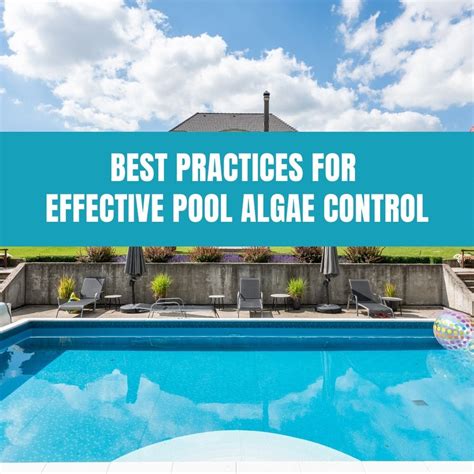Maintain a Clean Pool: Algaecide Application Strategies
Keeping your pool sparkling clean and inviting requires more than just regular vacuuming and filtration. A crucial element in pool maintenance is the proactive use of algaecide. This article delves into effective algaecide application strategies to prevent algae blooms and maintain a healthy, crystal-clear swimming environment. We'll cover everything from choosing the right algaecide to understanding application techniques and addressing common concerns.
What is Algaecide and Why is it Necessary?
Algaecide is a chemical designed to kill and prevent the growth of algae in swimming pools. Algae, a type of microscopic plant, can quickly turn your pool green, slimy, and unsafe for swimming. Different types of algae exist, each requiring specific treatment. Regular algaecide application is crucial for preventative maintenance, minimizing the need for more extensive and costly cleanups later. Ignoring algae growth can lead to slippery surfaces, unpleasant odors, and potential health hazards.
Choosing the Right Algaecide: Types and Considerations
Several types of algaecides are available, each with its strengths and weaknesses:
-
Copper-based algaecides: These are effective against various algae types but can stain pool surfaces if overused. They also require careful monitoring of copper levels in the water.
-
Non-copper algaecides: These are generally safer for pool surfaces and less likely to cause staining. They often contain quaternary ammonium compounds or other active ingredients.
-
Oxidizing algaecides: These algaecides, such as potassium monopersulfate (MPS), work by oxidizing algae cells, effectively killing them. They're often used in conjunction with other algaecides for broader effectiveness.
When selecting an algaecide, consider:
-
Your pool type: Different algaecides are suitable for various pool materials (e.g., concrete, fiberglass, vinyl).
-
Algae type: Identify the type of algae present (green, black, mustard) to select the most effective treatment.
-
Pool size and volume: This will determine the amount of algaecide needed for proper application.
Always follow the manufacturer's instructions carefully.
How to Apply Algaecide Effectively: A Step-by-Step Guide
Proper application is key to maximizing algaecide effectiveness. Here's a step-by-step guide:
-
Test your water: Before applying algaecide, test your pool water's pH and alkalinity levels. Adjust these to the recommended ranges before proceeding. Improper water chemistry can reduce algaecide efficacy.
-
Choose the right time: Applying algaecide in the evening or on a cloudy day can help prevent the sun from degrading the chemical too quickly.
-
Measure carefully: Use a measuring cup or device to accurately measure the required amount of algaecide based on your pool's volume and the product instructions.
-
Dilute (if necessary): Some algaecides require dilution before application. Follow the manufacturer's instructions carefully.
-
Apply evenly: Add the diluted algaecide to the pool while the pump is running. Allow the pool's circulation system to distribute the algaecide throughout the water.
-
Monitor and adjust: After application, continue to monitor your pool water chemistry and algae levels. You may need to repeat the application or adjust your maintenance schedule based on your observations.
-
Brush the pool walls and floor: This helps dislodge any algae clinging to surfaces, increasing the algaecide's effectiveness.
What Happens if I Overapply Algaecide?
Overapplying algaecide can lead to several issues, including:
-
Staining: Especially with copper-based algaecides.
-
Chemical imbalance: Disrupting the delicate balance of your pool's water chemistry.
-
Toxicity: In rare cases, excessive algaecide can create a slightly toxic environment.
If you suspect overapplication, test your water and consult a pool professional. They can advise on how to mitigate the effects and restore the balance of your pool's chemistry.
How Often Should I Apply Algaecide?
The frequency of algaecide application depends on several factors:
-
Climate: Warmer climates often require more frequent applications.
-
Pool usage: More frequent swimming increases the likelihood of introducing algae spores.
-
Algae type: Some algae are more persistent than others.
-
Pool cover usage: A pool cover helps reduce algae growth, reducing the frequency of applications.
Generally, preventative applications every 1-2 weeks are recommended, but regular testing and visual inspection are crucial to determine your specific needs.
What are the common problems encountered when using algaecide?
H2: What are the common problems encountered when using algaecide?
Common problems include ineffective treatment due to incorrect water chemistry, staining from copper-based products, and eye irritation if not handled carefully. Always follow the manufacturer's instructions and ensure your water chemistry is balanced.
H2: Can I use algaecide with other pool chemicals?
It's vital to check the compatibility of algaecide with other chemicals before mixing them. Some combinations can be dangerous or ineffective. Always follow manufacturer's instructions and consult a pool professional if unsure.
H2: What are the safety precautions when using algaecide?
Always wear appropriate protective gear, such as gloves and eye protection, when handling algaecide. Keep children and pets away from the area during application. Store algaecide in a cool, dry place, away from other chemicals.
By understanding algaecide types, application techniques, and potential problems, you can effectively prevent algae growth and maintain a pristine, safe swimming pool for yourself and your family. Remember, regular monitoring and preventative maintenance are key to a healthy and enjoyable pool experience.

